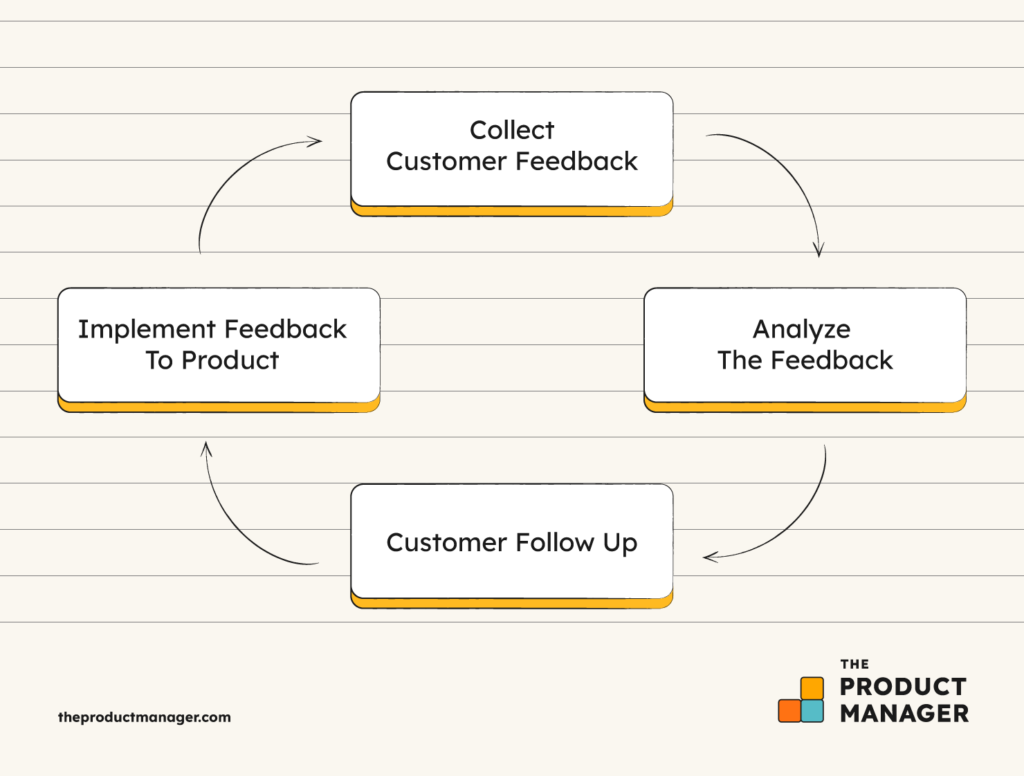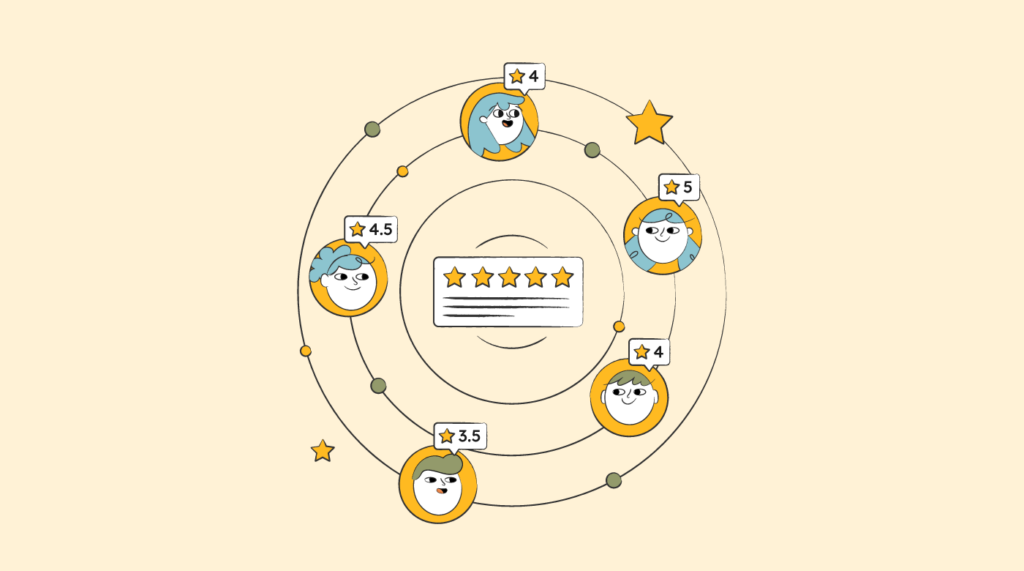I have recently talked about various methods of getting customer feedback during product development. In this article, I want to deep dive into one very valuable way of using customer feedback to improve your product continuously and keep customers happy—the customer feedback loop.
Retail research shows that 73% of customers abandon a brand after three or fewer bad customer experiences. In my work for eBay and the Guardian Soulmates dating site, I have learned how important customer feedback can be for customer loyalty and reduction of customer churn.
In this article, I will discuss some methods and practical applications of the various steps of a customer feedback loop.
What Is A Customer Feedback Loop
Creating a loop means that you not only collect customer feedback but that you feed findings back into your new product development and very importantly feed them back to your customers as well.

1. Collecting Customer Feedback
There are various ways to collect customer feedback about your live product. The most common ones are various types of surveys, but social media monitoring is also a very valuable tool.
Customer Surveys
A customer may take surveys at various touchpoints in the customer journey and the surveys can be proactive or reactive. Reactive surveys are pushed to users and get a higher volume of feedback. A proactive survey is only taken when the customer actively seeks it out.
Some examples of feedback surveys:
| Type of survey | What is it | Proactive / reactive | Purpose |
| NPS survey (Net Promoter Score) | A one-question customer satisfaction survey asking how likely a user is to recommend your product to others. | Reactive | Measures customer happiness with your product overall at a high level. |
| CSAT survey | A one-question survey asking how happy a user was with a particular transaction. | Reactive | Satisfaction score for a transaction. It is often used for customer support transactions. It can also show gaps in your help content. |
| Exit survey | A survey popping up when a user is leaving your product. | Reactive | Tells you about a pain point that led to the customer leaving. Very useful for conversion optimization or at critical touchpoints. |
| Persistent feedback button | A button on every screen that allows a user to leave feedback. | Proactive | This will capture anything really. It can tell you things that otherwise you would have not heard from customers. |
| Rating survey | A pop-up to rate the product. | Reactive | Mostly used as a star rating. This is best used to increase your reputation on app stores or review sites. Its use for actionable feedback is limited unless you also encourage comments. |
| Email surveys | A longer survey sent out to users with multiple questions | Reactive | This can be very useful as a focused deep dive into customers’ needs, for example how people use your search functionality. Be careful though who you send this to. Depending on your customers’ location an email survey may require an opt-in to receive marketing communications. |
Be mindful of the user experience, when you deploy surveys. A customer trying to complete a task in your product can easily be put off by pop-ups that get in the way.
Overall, in a B2C business, you want to use surveys sparingly and only for important touchpoints in the customer journey—for example, exits at important conversion points or after a customer support transaction. In a B2B business, especially with a Saas product, you have a closer customer relationship and they will likely be more willing to give you feedback.
Our article on product experience management tools contains some useful tools to easily create and integrate feedback surveys into your product based on customizable templates.
NPS Survey (Net Promoter Score)
NPS is a key metric that deserves a bit more explanation as it is a common way to track the perception of your overall product over time. It is only one question and typically gets a high response rate. There are also various industry benchmarks on what a good NPS score is—or whether NPS is inherently flawed.

A high NPS score means that you have a lot more promoters than detractors. This is a very good indicator that your customers are happy and loyal to your product. Bain & Company, the creators of the NPS system, say:
“On average, an industry's Net Promoter leader outgrew its competitors by a factor greater than two times.”
Every company should have an NPS survey, but the use for actionable product feedback is limited.
Social Media Monitoring
Many customers will not come directly to you with their negative or positive feedback. Instead, they will mention you on social media platforms. To see what they are saying about you, you can use a social media monitoring tool to inform you about mentions.
Reacting directly to social media posts, especially complaints, is a powerful tool for you to show your customers that you care about them and their experience.
Product Use Monitoring
Watching a customer interact with your product in real-time is invaluable. You can spot frustration points, favored features, and follow the user flow from entry point to exit. This can also fill the gap between what feedback people are giving and what actions they are taking. Is it a feature problem or a teaching problem? Session replays can help you find out.
You can also use user research tools like session replay software to see how customers are interacting with your website, app, or product.
2. Analyze The Feedback
So now you have a big collection of customer feedback data from all kinds of different sources. How do you get on top of this and keep it up to date? Well, first of all, it is useful to categorize the feedback into a few buckets.
- Quant metrics: metrics like NPS or CSAT, which are easy and important to track, but sometimes don’t directly give actionable insight into product issues.
- Bugs: depending on the number of reports and severity, bugs may be the top priority to act on.
- UX issues: these are issues where a user struggled because they did not understand how to use your product. For a customer, these often look like a bug!
- New feature ideas: customers sometimes come up with feature requests. These need to be interpreted carefully. A request for a feature may actually be an expression of an underlying need that may be better served by a different solution.
As a product manager, don’t be afraid of negative feedback as it can be very valuable to inform any future development. Collated customer feedback can be a great tool to make product prioritization decisions.
In some of my previous roles, I have simply consolidated the various pieces of feedback into a widely shared spreadsheet. I used the classification above and attached labels for product areas of improvement (e.g. help content, checkout flow, navigation). This way, we could easily filter for particular areas to tackle and address multiple pieces of feedback at once.
Related Read: 10 Best User Feedback Software To Improve Customer Satisfaction
3. Follow Up
Other representations of the customer feedback loop show this as the last step after implementing changes. However, it may be a long time until you can actually act on a particular piece of customer feedback. In order to make your customers feel valued, they should get a response to their feedback in a timely manner.
Mostly following up on user feedback will be done by the customer support team. But don’t be shy to reach out and talk to customers directly also as a product manager or UX researcher.
When I worked at eBay, the community forums were the main channel to communicate new features and gather customer feedback from eBay buyers and sellers. Not everybody always agreed with what was being done and discussions were sometimes heated. But eBay members always appreciated when a product manager or other members of the product team showed up to listen to their feedback and explain the rationale why changes were made.
Often this also led to further improvements and the posters were very happy to learn that they had made a difference.
Customers want to be taken seriously. Responding to feedback can be a case of keeping a customer instead of losing them! If you have a CRM system, you should also capture your contact with the customer there so that everybody knows that you have addressed their feedback.
4. Implement Findings
Implementing a customer feedback loop is a great way to drive constant improvements to your product. Changes based on customer feedback can be a great complement to your new feature product roadmap.
Typically in some of my previous roles, whenever we planned an overhaul of a particular area, we filtered the collated feedback sheet by product area and incorporated a lot of the improvements based on customer feedback.
Improvements to help content and customer service scripts don’t even need to wait for product development and can be done continuously.
Related Read: Product Roadmap Guide: Why It’s Important And Types You Should Know
Customer Feedback Loop — A Win-Win Initiative
Implementing a customer feedback loop can both drive continuous improvement to your product and also improve customer retention and loyalty. This is a win-win situation!
To get the ball rolling, you can start small by incorporating a little survey into your product at a critical conversion point to learn more about why customers behave a certain way at that point. My favorite tool to do this is Pendo, which allows me to serve up surveys based on previous behavior. You will probably be surprised what customers come up with! If you can, set aside half an hour weekly to talk to a customer that has given you feedback.
I would be very interested to read your comments on how you have integrated customer feedback into your role as a product manager.
If you want more practical tips and tricks to make your life as a product manager easier, why not subscribe to our newsletter.
Related List of Tools: User Tracking Software


